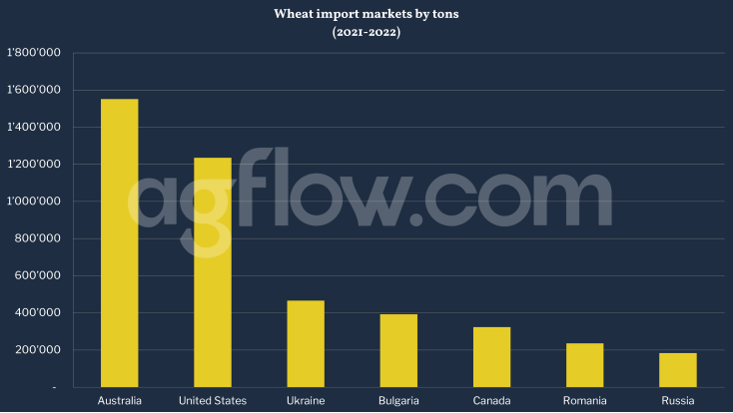South Korea to Provide Billion Wons for Wheat Sector
Reading time: 2 minute
According to Statistics Korea’s released on June 29, the Wheat cultivated area in 2022 was 8,259ha, an increase of 32.7% (2,035ha) from the 6,224ha of the previous year. By province, Jeonnam province led others with 3,277ha of cultivation, followed by Jeonbuk (2,852ha), Gwangju (892ha), and Gyeongnam (805ha).
The MY 2021/22 Wheat production estimate was revised to 29,835 metric tons (MT), increasing 33 percent from the previous forecast (or up 76 percent of the prior year) due to increased planting area and higher yields. MY 2020/21 Wheat production was 16,985 MT, up 13 percent from the previous year due to an 18 percent increase in planted area. Yields were 3.25 metric tons (MT) per hectare (ha), down 19 percent from the previous year due to unfavorable weather conditions.
MY 2022/23 (July 1-June 30) Wheat production is forecast at 30,000 MT, up one percent from the current marketing year estimate. The planting area for the 2022 crop was forecast at 7,500 hectares (ha), according to a farm planting intentions survey by the Korea Agro-Fisheries and Food Trade Corporation.
According to the USDA, MY 2022/23 Wheat consumption is forecast at 3.7 million metric tons (MMT), down 15 percent from the current marketing year estimate based on the assumption that feed Wheat consumption will revert towards the 1.3 MMT five-year average, while Food, Seed, and Industrial (FSI) consumption remains steady at 2.4 MMT
The country’s Wheat consumption is mainly dependent on import. As per AgFlow data, Australia shipped 1.5 million tons of Wheat in 2021-2022, followed by the US (1.2 million tons), Ukraine (0.4 million tons), Bulgaria (0.4 million tons), Canada (0.3 million tons), and Romania (0.2 million tons).

The Korean Government’s Wheat Policy
The Korean Government provides incentives to Wheat growers under the Presidential and Ministerial Decree ‘Fostering Act for Korean Wheat Industry’, effective February 28, 2020. The Act allows the Government to provide packaged support to domestic Wheat growers, including Government purchasing, breeding, and marketing programs.
The Government’s target for self-sufficiency in milling Wheat consumption by 2025 is 5 percent (equivalent to 120,000 MT), rising to 10 percent (equivalent to 240,000 MT) by 2030. However, planting intentions for the 2022 crop (7,500ha) is still less than the Government target (10,000ha), reflecting limited demand for locally grown Wheat, along with low interest among growers in the Government incentives.
The National Statistical Office analyzed that the reason for the increase in Wheat cultivation area was that the expectations of farmers following the promotion of the “Wheat Industry Promotion Policy” were reflected. The Ministry of Agriculture, Food and Rural Affairs has been establishing and promoting the “Basic Plan for the Promotion of the Wheat Industry” since 2021 to foster the domestic Wheat industry.
For stable production, South Korea planned the establishment of Wheat production complexes (39 in ’21 → 51 in ’22), support for facilities for drying and storage during harvest (2 in ’21 → 4 in ’22), and 50 seeds of the Government-supplied seeds. The country is promoting support projects to create a production base, such as certain discount supplies. In addition, to stabilize domestic Wheat prices and expand demand, the Government purchases (8,000 tons in 2021 → 17 thousand tons in 2022 are planned) and milling/processing support (new 1.6 billion won in 2022) are being promoted.
The Ministry of Agriculture, Food and Rural Affairs plans to further expand support for fostering the domestic Wheat industry so that farmers’ interest and participation in the Wheat industry promotion policy can be further developed. To expand Wheat cultivation area, the country plans to strengthen support for specialized production complexes and drying and storage facilities to create a production base, provide benefits to Wheat-producing farmers, and increase self-sufficiency by expanding the Government stockpile.
Other sources: https://www.korea.kr/
Free & Unlimited Access In Time

